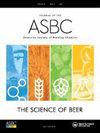Ability of Exogenous or Wort Endogenous Enzymes to Release Free Thiols from Hop Cysteinylated and Glutathionylated S-Conjugates
IF 1.8
4区 农林科学
Q4 BIOTECHNOLOGY & APPLIED MICROBIOLOGY
Journal of the American Society of Brewing Chemists
Pub Date : 2022-01-26
DOI:10.1080/03610470.2021.2021766
引用次数: 3
Abstract
Abstract Following identification of the substantial pool of aromas represented by cysteinylated and glutathionylated precursors in hop, many studies have focused on developing methods for releasing volatile thiols based on chemical hydrolysis or yeast activity. The present work aimed to evaluate the release activity of either commercially available exogenous enzymes or endogenous wort enzymes (issued from hop or malt) on synthetic Cys- or G-precursors of 3SHol, 3SPol, 3SHptol, 3S4MPol and 4S4M2Pone. In a model medium at pH 7.7, both apotryptophanase and cystathionine β-lyase appeared very efficient on Cys-adducts (up to 77.9% release). Interestingly, a slight proportion of this release (up to 0.9%) appeared to result from chemical hydrolysis. In polyphenols rich media such as hop and beer, total release was much lower (under 0.2%). For release from G-adducts, a combination of γGT and apotryptophanase proved to be effective, highlighting for the first time the ability of β-lyase activity to release free PFTs also from CysGly-adducts. The best release rates (above 2% for all thiols) were obtained with a two-step incubation: 75 units γGT with synthetic glutathionylated precursors for 16 h at 37 °C in the presence of alanine followed by apotryptophanase for 7 h at room temperature. The alternative combination of γGT with S. cerevisiae was found to release free thiols more efficiently than yeast activity alone. Compared to commercially available enzymes, endogenous enzymes extracted from hop or malt displayed lower efficiency (below 0.3% for γGT activity and below 0.002% for β-lyase).外源或Wort内源酶从啤酒花半胱氨酸化和谷胱甘肽化S-偶联物中释放游离硫醇的能力
摘要在鉴定了啤酒花中以半胱氨酰化和谷胱甘肽化前体为代表的大量香气之后,许多研究都集中在开发基于化学水解或酵母活性释放挥发性硫醇的方法上。本工作旨在评估市售外源酶或内源麦芽汁酶(由啤酒花或麦芽发出)对合成的3SHol、3SPol、3SHptol、3S4MPol和4S4M2Pone的Cys-或G-前体的释放活性。在pH为7.7的模型培养基中,载色氨酸酶和胱硫醚β-裂解酶对Cys加合物表现出非常有效的作用(高达77.9%的释放)。有趣的是,这种释放的一小部分(高达0.9%)似乎是由化学水解引起的。在富含多酚的培养基(如啤酒花和啤酒)中,总释放量要低得多(低于0.2%)。对于G加合物的释放,γGT和载色氨酸酶的组合被证明是有效的,首次突出了β-裂解酶活性也能从CysGly加合物中释放游离PFTs。通过两步孵育获得了最佳释放率(所有硫醇均超过2%):75单位γGT与合成谷胱甘肽化前体孵育16 h在37 在丙氨酸存在下,在°C下,然后用去胰蛋白酶进行7 h。γGT与酿酒酵母的替代组合比单独的酵母活性更有效地释放游离硫醇。与市售酶相比,从啤酒花或麦芽中提取的内源酶显示出较低的效率(γGT活性低于0.3%,β-裂解酶低于0.002%)。
本文章由计算机程序翻译,如有差异,请以英文原文为准。
求助全文
约1分钟内获得全文
求助全文
来源期刊

Journal of the American Society of Brewing Chemists
工程技术-生物工程与应用微生物
CiteScore
4.00
自引率
20.00%
发文量
41
审稿时长
3 months
期刊介绍:
The Journal of the American Society of Brewing Chemists publishes scientific papers, review articles, and technical reports pertaining to the chemistry, microbiology, and technology of brewing and distilling, as well as the analytical techniques used in the malting, brewing, and distilling industries.
 求助内容:
求助内容: 应助结果提醒方式:
应助结果提醒方式:


